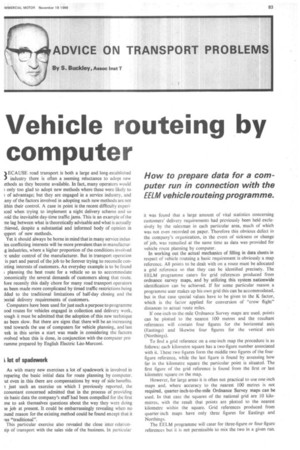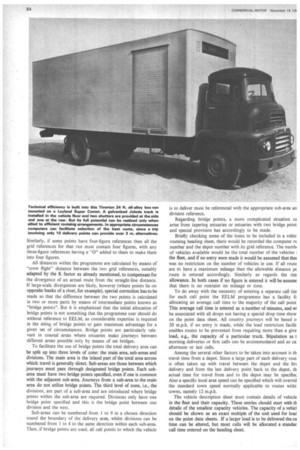ADVICE ON TRANSPORT PROBLEMS
Page 85

Page 86

If you've noticed an error in this article please click here to report it so we can fix it.
By S. Buckley, Assoc I nst T
Vehicle routeing by computer
) ECAUSE road transport is both a large and long-established industry there is often a seeming reluctance to adopt new ethods as they become available. In fact, many operators would only too glad to adopt new methods where these were likely to of advantage; but they are engaged in a service industry, and any of the factors involved in adopting such new methods are not ithin their control. A case in point is the recent difficulty experiiced when trying to implement a night delivery scheme and so mid the inevitable day-time traffic jams. This is an example of the me lag between what is theoretically advisable and what is actually thieved, despite a substantial and informed body of opinion in ipport of new methods.
Yet it should always be borne in mind that in many service indusies conflicting interests will be more prevalent than in manufacturig industries, where a higher proportion of the conditions involved re under control of the manufacturer. But in transport operation is part and parcel of the job to be forever trying to reconcile conicting interests of customers. An everyday example is to be found planning the best route for a vehicle so as to accommodate xmomically the several demands of customers along that route. lore recently this daily chore for many road transport operators as been made more complicated by timed traffic restrictions being clded to the traditional limitations of half-day closing and the pecial delivery requirements of customers.
Computers have been used for just such a purpose to programme ood routes for vehicles engaged in collection and delivery work, sough it must be admitted that the adoption of this new technique as been slow. But there are signs that there will be an increasing rend towards the use of computers for vehicle planning, and last reek in this series a start was made in considering the factors ivolved when this is done, in conjunction with the computer proramme prepared by English Electric Leo-Marconi.
1 lot of spadework As with many new exercises a lot of spadework is involved in reparing the basic initial data for route planning by computer. ;tit even in this there are compensations by way of side benefits. a just such an exercise on which I previously reported, the ccountant concerned admitted that in the process of providing us basic data the company's staff had been compelled for the first me to ask themselves questions about the way they were doing 2e job at present. It could be embarrassingly revealing when no ound reason for the existing method could be found except that it ras "traditional".
This particular exercise also revealed the close inter-relationlip of transport with the sales side of the business. In particular it was found that a large amount of vital statistics concerning customers' delivery requirements had previously been held exclusively by the salesman in each particular area, much of which was not even recorded on paper. Therefore this obvious defect in the company's organization, in the event of sickness or change of job, was remedied at the same time as data was provided for vehicle route planning by computer.
In working out the actual mechanics of filling in data sheets in respect of vehicle routeing a basic requirement is obviously a map reference. Al] points to be dealt with on a route must be allocated a grid reference so that they can be identified precisely. The EELM programme caters for grid references produced from ordnance survey maps, and by utilizing this system nationwide identification can be achieved. If for some particular reason. a programme user makes up his own grid this can be accommodated, but in that case special values have to be given to the K factor, which is the factor applied for conversion of "crow flight" distances to actual route miles.
If one-inch-to-the-mile Ordnance Survey maps are used, points can be plotted to the nearest 100 metres and the resultant references will contain four figures for the horizontal axis (Eastings) and likewise four figures for the vertical axis (Northings).
To find a grid reference on a one-inch map the procedure is as follows: each kilometre square has a two-figure number associated with it. These two figures form the middle two figures of the fourfigure reference, while the last figure is found by assessing how far in the kilometre square the particular point is situated. The first figure of the grid reference is found from the first or last kilometre square on the map.
However, for large areas it is often not practical to use one-inch maps and, where accuracy to the nearest 100 metres is not required, quarter-inch-to-the-mile Ordnance Survey maps can be used. In that case the squares of the national grid are 10 kilometres, with the result that points are plotted to the nearest kilometre within the square. Grid references produced from quarter-inch maps have only three figures for Eastings and Northings.
The EELM programme will cater for three-figure or four-figure references but it is not permissible to mix the two in a given run.
Similarly, if some points have four-figure references then all the grid references for that run must contain four figures, with any three-figure references having a "0" added to them to make them into four figures.
All distances within the programme are calculated by means of "crow flight" distance between the two grid references, suitably adapted by the K factor as already mentioned, to compensate for the divergence of an actual route from the straight-line distance. If large-scale divergences are likely, however (where points lie on opposite banks of a river, for example), special correction has to be made so that the difference between the two points is calculated in two or more parts by means of intermediate points known as "bridge points". But it is emphaSixed that the initial allocation of bridge points is not something that the programme user should do without reference to EELM, as considerable expertise is required in the siting of bridge points to gain maximum advantage for a given set of circumstances. Bridge points are particularly relevant in coastal areas where estuaries make journeys between different areas possible only by means of set bridges.
To facilitate the use of bridge points the total delivery area can be split up into three levels of zone: the main area, sub-areas and divisions. The main area is the inland part of the total area across which travel is generally direct. Sub-areas are those between which journeys must pass through designated bridge points. Each subarea must have two bridge points specified, even if one is common with the adjacent sub-area. Journeys from a sub-area to the main area do not utilize bridge points. The third level of zone, i.e., the divisions, are part of a sub-area and are introduced where bridge points within the sub-area are required. Divisions only have one bridge point specified and this is the bridge point between one division and the next. , Sub-areas can be numbered from 1 to 9 in a chosen direction round the boundary of the delivery area, whilst divisions can be numbered from 1 to 4 in the same direction within each sub-area. Then, if bridge points are used, all call points to which the vehicle is to deliver must be referenced with the appropriate sub-area an division reference.
Regarding bridge points, a more complicated situation ca arise from tapering estuaries or estuaries with two bridge point and special provision has accordingly to be made.
Briefly checking some of the items to be included in a vehic routeing heading sheet, there would be recorded the computer ni number and the depot number with its grid reference. The numb of vehicles available would be the total number of the vehicles] the fleet, and if no entry were made it would be assumed that thei was no restriction on the number of vehicles in use. If all route are to have a maximum mileage then the allowable distance pe route is entered accordingly. Similarly as regards the tim allowance. In both cases if no figure is entered it will be assume that there is no restraint on mileage or time.
To do away with the necessity of entering a separate call tim for each call point the EELM programme has a facility fc allocating an average call time to the majority of the call point This average call time is entered as a number of minutes, and wi be associated with all drops not having a special drop time show on the point data sheet. All country journeys will be based o 20 m.p.h. if no entry is made, while the load restriction facilit enables routes to be prevented from requiring more than a give load, e.g., the capacity of a particular truck. Stipulation as t morning .deliveries or first calls, can be accommodated and so ca afternoon or last calls.
Among the several other factors to be taken into account is th travel time from a depot. Since a large part of each delivery rout is often taken up with travel between the depot and the firE delivery and from the last delivery point back to the depot, th actual time for travel from and to the depot may be specifiec Also a specific local area speed can be specified which will overrid the standard town speed normally applicable to routes withi towns, namely 12 m.p.h.
The vehicle description sheet must contain details of vehicle in the fleet and their capacity. These entries should start with tl details of the smallest capacity vehicles. The capacity of a vehicl should be shown as an exact multiple of the unit used for load on the point data sheets. If a larger load is to be delivered the ca time can be altered, but most calls will be allocated a standar call time entered on the heading sheet.




































































































































